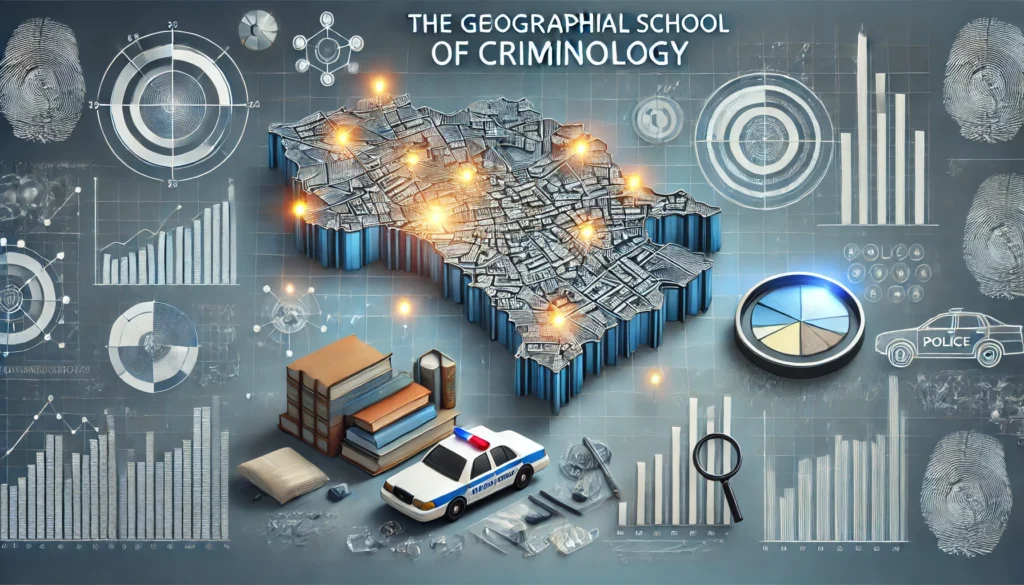The Geographical School of Criminology is a pivotal framework within criminological studies that focuses on understanding crime through its spatial distribution and environmental influences. This school of thought provides a unique lens to analyze how geographical and social factors shape criminal behavior, emphasizing the non-random distribution of crime and its association with specific locations. The following exploration delves into the origins, principles, applications, critiques, and modern developments of this influential school.
Origins and Historical Development
The Geographical School of Criminology emerged during the 19th century as part of a broader intellectual movement to apply scientific methods to the study of social phenomena. This school’s roots can be traced back to pioneering works in Europe, particularly in France and Belgium, where scholars utilized statistical tools to investigate crime patterns.
Adolphe Quetelet: The “Average Man”
Adolphe Quetelet (1796–1874), a Belgian mathematician and sociologist, played a foundational role in establishing the Geographical School. Quetelet introduced the concept of the “average man” (“homme moyen”) and sought to understand how social and environmental factors influenced behavior. His studies revealed:
- Crime rates vary significantly by region.
- Factors such as age, gender, education, and economic conditions correlate with criminal activity.
- Environmental factors, including climate and urbanization, influence crime patterns.
Quetelet’s work demonstrated that crime is not a random phenomenon but rather follows observable patterns influenced by societal structures.
André-Michel Guerry: Mapping Crime
Another key figure, André-Michel Guerry (1802–1866), is often regarded as one of the first criminologists to systematically map crime data. Using early statistical techniques, Guerry’s research highlighted:
- Regional disparities in crime rates.
- Relationships between crime and literacy rates.
- The role of economic inequality in shaping criminal behavior.
Guerry’s maps laid the groundwork for modern crime mapping and spatial analysis, reinforcing the idea that environmental and social factors are crucial in understanding crime.
Core Principles of the Geographical School
The Geographical School is built on several foundational principles, which emphasize the interplay between location, environment, and crime. These principles have evolved over time but remain central to its approach.
1. Spatial Distribution of Crime
One of the core tenets is the non-random distribution of crime. Studies reveal that criminal activity often clusters in specific areas due to factors like:
- Urbanization and population density.
- Economic disparities and poverty.
- Proximity to industrial or commercial centers.
For instance, urban areas with higher population densities often experience more crime due to increased opportunities for criminal behavior and social stressors.
2. Environmental Determinism
Environmental determinism posits that physical and geographical factors influence human behavior. Historical perspectives often linked warmer climates with higher rates of violent crime, based on the belief that heat contributes to aggression. While this view has been refined, the role of environment in shaping behavior remains a key focus.
3. The Social Environment
The school’s analysis extends beyond physical geography to include social structures. Factors such as:
- Unemployment rates.
- Educational opportunities.
- Community cohesion and cultural norms.
are integral to understanding the geographical concentration of crime.

4. Crime Mapping and Statistical Analysis
The use of statistical methods and mapping tools is a hallmark of the Geographical School. By analyzing data on crime rates and locations, scholars identify patterns that inform policies and interventions.
Modern Applications
The principles of the Geographical School have evolved to incorporate advanced technologies and interdisciplinary approaches. These applications are essential for contemporary criminological research and practice.
1. Geographic Information Systems (GIS)
GIS technology has revolutionized crime mapping, allowing for:
- Visualization of crime hotspots.
- Analysis of temporal patterns (e.g., seasonal variations in crime).
- Integration of demographic and socioeconomic data to identify risk factors.
For example, law enforcement agencies use GIS to deploy resources more effectively and design targeted crime prevention strategies.
2. Crime Prevention Through Environmental Design (CPTED)
CPTED applies geographical principles to urban planning and architecture. By modifying physical environments to reduce opportunities for crime, CPTED strategies include:
- Improving street lighting.
- Designing public spaces to increase natural surveillance.
- Implementing access control measures in residential and commercial areas.
3. Urban Studies and Policy Development
The Geographical School informs urban studies by highlighting the connections between spatial planning and crime. Policymakers use these insights to:
- Address socioeconomic inequalities.
- Improve public transportation networks to enhance community safety.
- Develop affordable housing programs to mitigate crime-related stressors.
Key Studies and Findings
Over the decades, numerous studies have validated and expanded upon the principles of the Geographical School. Key findings include:
1. Urban vs. Rural Crime
Crime rates are generally higher in urban areas due to factors like population density, economic disparity, and anonymity. However, certain types of crime, such as property theft, may also occur in rural areas where law enforcement resources are limited.
2. Seasonal Variations
Research indicates that crime rates fluctuate with seasons, with certain crimes, like burglary, peaking in winter months. This variation underscores the influence of environmental and social conditions.
3. Socioeconomic Disparities
Areas with high poverty levels and limited access to education and healthcare often experience elevated crime rates. These findings highlight the importance of addressing systemic inequalities as part of crime prevention efforts.
Critiques and Limitations
While the Geographical School has contributed significantly to criminology, it is not without its critiques. These include:
1. Oversimplification of Crime
Critics argue that focusing too heavily on geographical factors can oversimplify the complexity of criminal behavior. Crime is influenced by a combination of:
- Psychological factors.
- Sociocultural norms.
- Individual choices.
2. Risk of Environmental Determinism
Overemphasizing the role of geography may lead to deterministic conclusions that ignore human agency and societal interventions.
3. Ethical Concerns
The use of crime mapping and data analysis raises ethical questions, particularly regarding privacy and the potential for stigmatizing certain communities.
Integration with Other Criminological Theories
The Geographical School is most effective when integrated with other criminological theories. For example:
- Sociological Theories: Understanding how social structures and cultural norms interact with geography.
- Routine Activity Theory: Examining how daily routines and urban designs create opportunities for crime.
- Psychological Perspectives: Investigating individual traits alongside environmental influences.
Future Directions
The Geographical School continues to evolve, with new technologies and interdisciplinary research expanding its scope. Key areas of future development include:
1. Big Data and Predictive Analytics
The integration of big data allows criminologists to predict crime trends with greater accuracy. Predictive policing models, though controversial, are being refined to address concerns about bias and ethics.
2. Climate Change and Crime
Emerging research examines the impact of climate change on crime patterns, exploring how extreme weather events and resource scarcity may influence criminal behavior.
3. Globalization and Transnational Crime
As globalization reshapes the world, the Geographical School must adapt to study transnational crimes, such as human trafficking and cybercrime, which transcend traditional geographical boundaries.
Conclusion
The Geographical School of Criminology provides a vital framework for understanding the spatial dimensions of crime. By analyzing the interplay between environment, society, and behavior, this approach offers actionable insights for policymakers, law enforcement, and urban planners. While it has limitations, its integration with modern technologies and interdisciplinary methods ensures its continued relevance in addressing the complex challenges of contemporary criminology. As crime patterns evolve, the Geographical School remains a cornerstone in the quest to create safer and more equitable societies.

